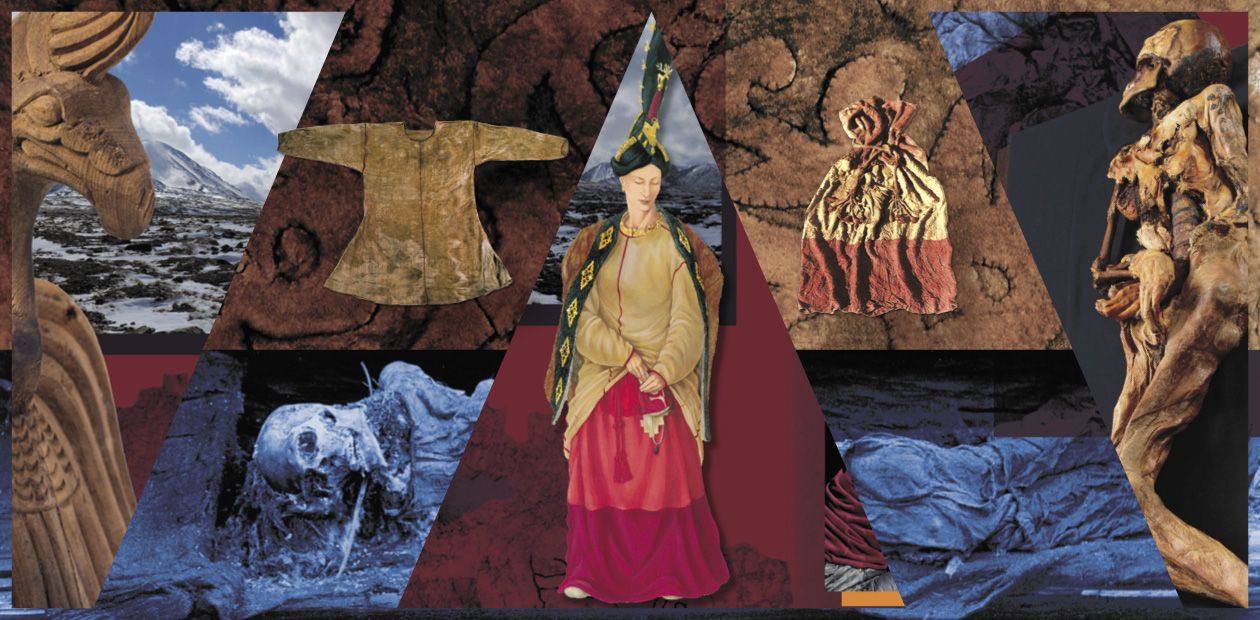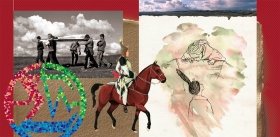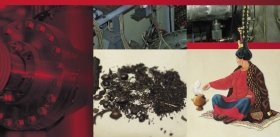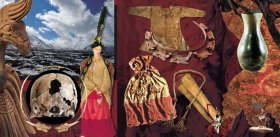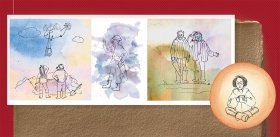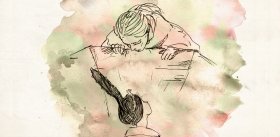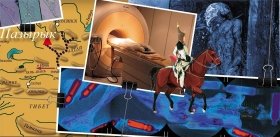On the Path to Celestial Pastures
The first mummies of the Pazyryk people were discovered in the mid-20th century during excavations in Eastern Altai. In 1993 the world saw a truly sensational discovery: in the mound Ak-Alakh-3 on the Ukok Plateau, archaeologists found a “frozen” sepulcher with the mummified body of a young Pazyryk woman and a set of items accompanying her to the other world. Among all the Pazyryk findings, the woman buried on Ukok attracted the greatest public attention.
Although over two decades have passed since the discovery of her embalmed remnants, the posthumous fate of the Ukok Princess remains the topic of a heated debate. There is compelling evidence of a high status of the buried woman, i.e., the accompanying burial of a man and three racing horses and the rare outlandish items such as silks and coriander seeds as well as the solitary position of the mound, which was located at a prominent point in a river valley. A tomographic study of the mummified remnants, which was conducted two decades after the discovery, revealed new facts supporting the archaeologists’ hypothesis about a special status of the buried woman as a Spirits’ Chosen, thus providing a unique insight into the life and death of a woman who lived more than 2,500 years ago
The first mummies of the Pazyryk people were discovered in the middle of the twentieth century by the Russian archaeologist and anthropologist S. I. Rudenko while he was carried out excavations in Eastern Altai. In 1993, a “frozen” sepulcher with the mummified body of a Pazyryk woman was discovered on the Ukok Plateau; two years later, another sepulcher with the mummy of a young man was found there. Of all these amazing finds, the mummy of the woman buried on Ukok attracted the most public attention.
Though more than twenty years have passed since the embalmed remnants of the Ukok Princess, as she became known in the media, were discovered, her posthumous fate remains a topic of heated debates. Ethnographers would probably explain this phenomenon by the fact that a critical situation gives rise to the reproduction of a whole range of cultural elements typical of spiritual culture of a certain ethnic group. In any case, since this phenomenon exists, it requires analysis and interpretation.
It was the first undamaged “frozen” sepulcher of an outstanding representative of Pazyryk culture, discovered over the whole period of its study, which started in the mid-nineteenth century. The first thing that makes an unforgettable impression is the fact that the burial-place has remained untouched. The man accompanying the woman into the other world “got in the way” of the robbers, who penetrated into the sepulcher through a small hole in the center of the mound; they got satisfied with destroying the male burial-place and did not notice the large larch vault under it.
The male burial-place located at the intersection of the main sepulcher is not at all typical of Pazyryk culture: it is truly exceptional. Taking into account the fact that the man was killed with a blow of a blunt object on the back of the skull, it can be claimed with a high degree of certainty that here we deal with a tradition of “simultaneous” death, when a person leaves this world not alone but in the company of people he or she needs in the other world. Together with the man, there was the body of a teenager, also discovered in the sepulcher, whose cause of death remained undetermined for lack of anthropological material; and there were the bodies of three racing horses. This accompanying vault immediately shows how important this woman was for her fellow tribesmen.
In addition to the unusual group of people and things accompanying the woman to the other world, the mound itself attests to her special position in society. It is located in a prominent open place in the valley of the river Ak-Alakh. Pazyryk culture is characterized by the presence of family and ancestral cemeteries, consisting of many mounds lying in a chain. A singly standing mound can attest to the fact that the woman did not belong to a particular tribe or family, but was related to all Pazyryk people who lived on theUkok Plateau. It can possibly point to her celibacy, which was typical of shamans and the clergy.
A lonely mound
Even though the mound is not big, about 18 m in diameter, everything connected with the burial ceremony under the conditions of a highland pasture, with no forest around, took a lot of time and effort and required a certain level of mastery and knowledge. Judging by the labor effort, all the Pazyryk people living on Ukok in winter must have taken part in burying this unusual woman.
On the bottom of the burial pit at the depth of three meters, an arch framework measuring 2.30 by 3.60 m was erected. By its northern outside wall, in the narrow space, there lay horses killed with a blow of a horseman’s pick. The horses had been put in harness decorated with wooden carving; they had soft felt saddles with applique ornaments. It seems unusual all the more since the Pazyryk women were rarely accompanied to the other world even by one horse. In the so-called utility area of the frame two wooden dishes-tables with meat and four vessels made of clay, wood and horn, with drinks, were arranged on the pebbled floor covered with a thick layer of felt.
The mummified body of the woman was placed into a massive arch hollowed-out log with a lid fastened with copper nails on two sides. All other conditions being equal, the bodies buried in such hermetically sealed logs had more chances to remain imperishable. The woman’s body in a sleeping posture laid on its right side on a thick felt cover, with her legs slightly bent at the knees; there was a small pillow under her head, which was covered in a wig topped with a tall hat. Her clothes, typical of the Pazyryk women, consisted of a robe, a woolen skirt fastened with a cord-like belt with tassels, and felt stockings. The robe was made of silk, while the neck was decorated with a wooden grivna covered with golden foil and having eight figurines of winged snow leopards. She had tiny golden rings in her ears and her headgear was decorated with 14 wooden figurines of birds.
An unusual mirror, unique in many ways, in a wooden frame with a deer image, was another thing discovered in the sepulcher. It was a metal plate whose elemental composition was mainly the same as of Khan mirrors. There was a small stone dish with partially charred coriander seeds (previously they had been found only in “kingly” burial mounds), which were often used as incense. Note that coriander seeds originated from the Mediterranean area; coriander was grown in India, Palestine and Egypt, while in its wild form it was found in the Caucasus, in Central Asia and in the black earth belt of the European part of Russia (Aseyeva, Naidakova, 1991).
The most important part of the burial ceremony was mummification. That the described woman had a high status in society is attested by the quality of mummification, which was performed with a maximum number of operations typical of mummified bodies buried in Pazyryk’s “kingly” mounds.
The first mummies of the Pazyryk people were discovered as early as in 1948 by S.I. Rudenko during the excavation in the valley of the river Bolshoy Ulagan in Eastern Altai. Two mummified men and two mummies of women were discovered in Mounds 2 and 5 of the Pazyryk burial ground.The skin of the man from Mound 2 was tattooed. After being extracted from the tomb, the body began to decay very fast; therefore, S. I. Rudenko decided that the mummy should be dissected. The tattooed skin as well as the mummified head and the right-hand wrist, which had been cut off by the grave robbers, were preserved separately. The other mummies, those of two women (40 and 50 years of age) and of a 55-year-old man were transported to Leningrad in the shape they had been discovered (one woman’s mummy had been partially dismembered by the robbers). These mummies are now to be found in the Hermitage in Saint-Petersburg
To prepare the woman’s body for its transition to the other world a number of operations were conducted with it. Skull trepanation was performed; the brain and organs in the facial part of the skull were extracted; and the chest cavity and abdomen were cut open. This was followed by the removal of all inner organs and the incision of vertebrae in the breast and sacrum parts to give the body a posture necessary for the burial. Then the head was separated from the body and the freed cavities were filled with a specially prepared organic filler (Polosmak, 2001). In addition, the skin was covered with some mercury-containing substance. Note that to mummify the Pazyryk man from mound 2 of the Verkh-Kaldzhin-2 burial ground, only a minimal number of operations were performed; the opened abdominal cavity, freed from the inner organs, was not filled with anything and was only partially stitched.
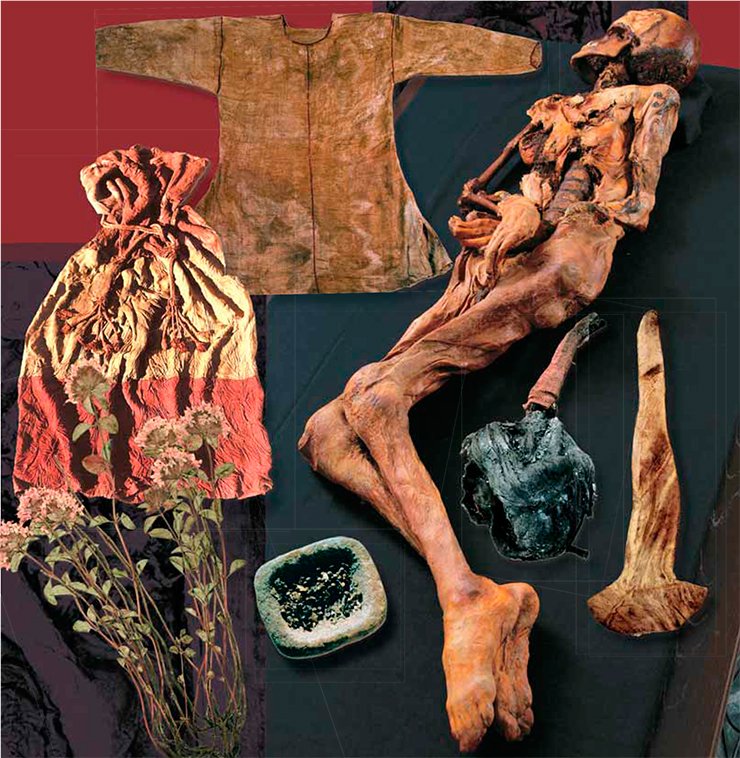
Thanks to the fact that the woman’s body was well-preserved, the tattoo covering her arms and shoulders can be clearly seen. Luckily, we were able to preserve them. The woman’s skin was covered in permanent, very skillfully drawn, images of real and mythical animals typical of Pazyryk art, including the tattoos that were widely spread.
Archaeological evidence
Since the female burial on Ukok is the only unspoiled, frozen sepulcher of a representative of the Pazyryk elite, we were able to see, for the first time, a complete set of objects accompanying a noble Pazyryk woman into the other world. What made up her wealth? Which of the discovered objects attest to her unusual status?
It should be admitted that all the objects discovered in the sepulcher have their counterparts in the other Pazyryk ordinary and “kingly” burial-place. No golden objects except for wire earrings have been discovered; though it should be pointed out that all the carved wooden jewelery both on the buried woman and on the horses accompanying her were covered with golden foil. However, this too is a feature characteristic of Pazyryk culture in general, fragments of such foil being present in any ordinary burial-place.
The wealth and status of the Pazyryk people seem to be underlined by rare, unusual things which found their way to Pazyryk from far away. In this sepulcher there are quite a few such things, starting with the wild silk from which the female robe was made and coriander seeds which served as incense, and finishing with the miniature bronze pendents shaped as small pots, whose origin is associated with Tagarsk culture. Finally, there was the mirror made from a piece of a Chinese mirror, which was of big value for the Pazyryk people; this fragment was inserted into a wooden frame, which turned it into a new object.
It is impossible to single out any special culture-specific cult objects among those discovered both in the sepulcher and in the burial mound as a whole. It brings us back to the question whether there was any difference between the sacred and the secular in the ancient world. People could assign some specific meaning to any objects depending on the situation: there were no ordinary in the modern sense of the word things at that time. That is why trying to find some objects pointing to her special spiritual status does not make any sense because everything surrounding her could bear a sacred meaning as we understand it thanks to the personality of the princess herself.
Today, twenty years after the discovery was made, we have managed to learn something that changes our idea about both the buried woman and the Pazyryk society as a whole. We learned about the causes of her death, which to a considerable extent explain various aspects of her life.
Reconstruction based on the medical data
The Pazyryk Princess suffered from osteomyelitis. This rather serious disease accompanied by bouts of pain and systemic infection was caused by unfavourable living conditions and traumas.
When she was a little over twenty years old, she developed another serious disease, breast cancer, which was devouring her during the last five-seven years of her life. She arrived at the winter camp on Ukok in October in critical condition; in modern terms, she had the last, terminal stage of breast cancer. This stage is characterised by severe pains and the highest level of intoxication leading to the loss of physical strength.
Being in such a state, she must have fallen off the horse and received severe injuries. She fell on the right side of the body, with the right temple, right shoulder, and the right hip all having suffered in the fall. However, her right arm did not suffer because it was held tight to the body. Probably, by that time her arm had stopped functioning, which is attested by the pathological changes in its tissues, reflecting, in fact, the process of decay in the living tissue. However, even after having suffered such a trauma, she may have stayed alive, for there are some lifetime edematous changes in the inguinal and axillary regions.
The magnetic resonance imaging (MRI) test allowed the researchers to detect in the mummy a number of foci abnormalities with an enhanced magnetic resonance signal intensity. There can be several explanations of the origin of these foci; however, it is clear that they point to a rather serious disease which could have caused death. We shall mention two most common hypotheses of the origin of fatal foci, the more so because the MRI signal clearly shows their separation into two groups. According to one hypothesis there was osteomyelitis as a manifestation of a general septic process; the other hypothesis is that the woman had cancerWhy do we think that the fall took place during her migration to the winter camp? The answer is that in her condition, characterized by an extreme level of exhaustion, intoxication, bedsores forming on her back and the right arm lymphedema, migration could be the only reason for the woman to mount a horse and get under way. The sick woman was not abandoned or killed to rid her of pain but was taken on this trip. Obviously, after arriving at Ukok she became permanently bedridden.
The presence of tight lumps in the right axillary space and another lump in the right mammary gland point to a life-time process spreading from the enter to the periphery <…>. From the point of view of pathological anatomy, it can be supposed that here we deal with the tissues that have anomalous characteristics; there must have been a primary tumor in the right mammary gland and lymph nodes containing metastatic tumorsIn the opinion of the pathologists who examined the mummy’s condition, the body may have been preserved for two or three months, for half a year at the most. The funeral took place in the middle of June, which is attested by the last fodder of one of the horses buried together with the woman; it consisted of twigs whose yearly rings had formed new cell cultures typical of that time of the year. The analysis of the pollen showed that the burial took place under the conditions typical of spring in the Altai highlands.
Based on these data, it can be concluded that the woman died either in January or in March. In any case, she did not die immediately from a head injury, which would have rid her of pain and suffering . Instead, she must have lived for another 3 to 5 months, being bedridden all the time. Without any doubt, before she died she had been in critical condition. Here, then, it is quite appropriate to remember how the well-known researcher of Yakut shamanism A. A. Popov (2006) described the last days of shamans. He pointed out that they usually died in terrible pain.
Illness as a gift
Imagine a woman exhausted from her illness and suffering from the most severe pain, who had to lie for several months in a winter log cabin poorly heated with pressed dung. Judging by the winter log cabins one can see on Ukok today, modern winter dwellings do not differ greatly from those the Pazyryk people lived in. Moreover, they are located in the same places as in the past. For centuries cattle breeders have unmistakenly chosen the most convenient and suitable hidden places for their winter camps, which are protected by the ancient moraines from the strongest winter winds that blow out the snow and free the pastures for the cattle.
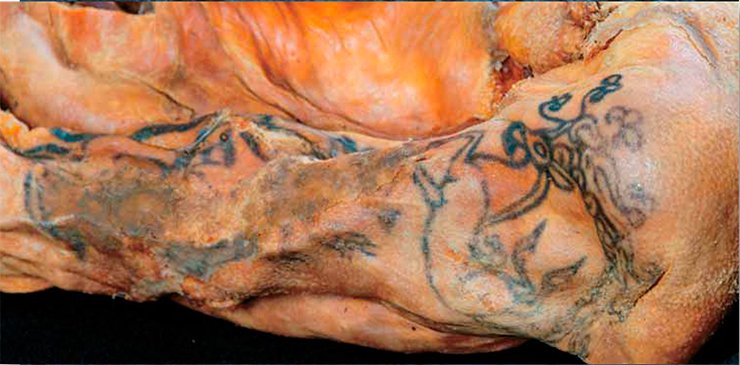
The paleopathological analysis of anthropological material from the Pazyryk sepulchers on Ukok has shown that almost all the bones of the people from Ukok reveal the symptoms of a severe physiological stress, the population having been constantly exposed to the extreme environment of the region. The Pazyryk people suffered from different types of chronic polyarthritis, which often manifested itself in arthrosis deformans of the major and minor joints of the upper and lower limbs. They also had osteochondrosis, i.e. deformation of joint surfaces of vertebra, and vertebral ankylosis, i.e. deformation of the spinal cord ligaments, sometimes accompanied by ankylosing spondylitis. Besides, single cases of ankylosing spondylitis of the ligaments of sacroiliac joints and cases of spondylolysis, i.e. deformation of the vertebral arch, were detected (Chikisheva, 2003).
Using these data, we may conclude that almost all Pazyryk people suffered from different diseases which, to a certain extent, limited their physical abilities, making them overcome pain every day. Besides, some of them suffered from the diseases that required constant help and care from others. The causes of these diseases were connected not only with the specific features of the environment but also with the lifestyle of horsemen and breeders.
The changes in the right hip also occurred in the woman’s lifetime. Together with the post-traumatic deformity in the right capitellum, deformity in anterior cruciate ligament of the right knee-joint and sublisthesis type deformity in the lumbar part of spinal cord, they make it possible to suppose that the woman suffered from a serious injury during her lifetime. She could have received it when she fell off the horseWhat kind of society was it then, with people being physically ill but having strict moral? What made the tribesmen first take care of the sick woman and then bury her in a way that women were rarely buried in that society – with full honors? The results of the computer tomography of the mummy supported our hypothesis, based exclusively on archaeological materials, that the woman buried in the mound of burial ground 1 in Ak-Alakh-3 had enjoyed a special status and was somebody we can call the Spirits’ Chosen. The hypothesis was also supported with new facts.
From numerous ethnographic sources it is well-known that the birth of a shaman is preceded by a long-term illness of the person. As early as the end of the 19th century, some scientists claimed that Indo-European shamanism had been born out of a real illness; only later shamans started falling into real trance (Wilke, 1887). We can suppose that it was the developing illness that formed the basis for the calling of the “woman from Ukok”, which limited her physical abilities but broadened her capacity for inner concentration and meditation, and made her behave ascetically. The illness, which have an unexplainable supernatural origin and caused unbearable suffering, could make her stand out of the crowd. M. Eliade vividly described it as follows: “she [the woman] experienced the sacred with a greater intensity than the rest of the society” (Eliade, 1964). In addition, she, of course, had some outstanding personal traits, which would have become apparent anyway. Without any doubt, what we deal with here is a clear combination of unique character traits with the consequences of a severe disease.
What deserves special attention is that she might have used painkillers, with evident consequences following. In the ancient cultures which left written evidence, the following substances were used as painkillers: wine, opium, hashish, henbane, mandrake extract, wolfsbane, and Indian hemp (Mirskiy, 2000). The Pazyryk people were familiar with hemp and with its properties. The hemp seeds discovered in the “kingly” burials were used in ritual as incense.
Shamanism, the techniques of going ecstatic, and transpersonal experiences resulting from using hemp were known to the Scythians and were described by Herodotus. This was supported by the archaeological material related to Pazyryk culture (Rudenko, 1953). Using hemp to reach the state of trance was also typical of ancient Iranian culture: it was the Iraninan word for hemp that was used to designate mystical intoxication in Central and Northern Asia (Eliade, 1964).
Constant inhaling of hemp vapor seems to have become a dire necessity for the woman (Polosmak, Trunova, 2004), and she often found herself in the state of altered consciousness. When she was in such a state, the souls of the dead predecessors, spirits and gods might have spoken through her. Such skills and knowledge, acquired at the subconscious level under the influence of hallucinogenic drugs (in this case, hemp), were highly valued by that society. The ecstatic visions of the woman were likely to let to consider her an exceptional, selected, necessary creature, who acted for the benefit of society as a whole. She may have been useful and necessary for the people in this particular role – the Spirits’ Chosen. This was the reason why the tribe took care of her and looked after her until her last breath.
The mummies into which the Pazyryk people turned their dead serve as evidence of an ancient ritual, vividly demonstrating the attitude of those people to life, death and immortality. The mummies of the Pazyryk people are an exceptional cultural phenomenon, an ancient Iranian tradition miraculously preserved till the present day. The Persian and Scythian kings must have been mummified in the same way as was practiced by the Pazyryk people.
The mummies carry a lot of hidden information, some of which has already been decoded; however, a lot remains unknown because the necessary methods and approaches are not yet available. The mummies may contain the kind of information we cannot be aware of at present.
Ancient mummies must be taken care of and preserved. They should wait for their time to come, for new discoveries are possible even after several decades after the objects were first discovered. This was the case with the mummies found in the Pazyryk mound: the infrared test conducted half a century after their being kept in the Hermitage discovered magnificent tattoos on their bodies (Barkova, Pankova, 2006). A similar story happened to the mummy of the young woman from Ukok, about whose life and death we learned only recently, several dozen years after her discovery. I am sure that this is far from being the end of the story.
References
Eliade M. Shamanism: Archaic Techniques of Ecstasy.
London: Routledge and Kegan Paul, 1964.
Polosmak N. V., Trunova V. A. Mortal delight. SR finds the murderer // Science First Hand, 2006, No. 2 (7). P. 38—49.
Polosmak N. V. Twenty years after // Science First Hand, 2014. No. 1 (37). P. 6—23.
Barkova L. L., Pankova S. V. Tatuirovka na mumijah iz Pazyrykskih kurganov v infrakrasnyh luchah // Vestnik istorii, literatury, iskusstva. 2006. T. 3. S. 31—42. (in Russian)
Mirskij M. B. Hirurgija ot drevnosti do sovremennosti. Ocherki istorii. M.: Nauka, 2000. 778 s. (in Russian)
Polos’mak N. V., Trunova V. A. Volosy iz pazyrykskih mogil: Rentgenofluorescentnyj analiz s ispol’zovaniem sinhrotronnogo izluchenija // Arheologija, jetnografija i antropologija Evrazii. 2000. № 1 (17). s. 73—80. (in Russian)
Polos’mak N. V. Vsadniki Ukoka. Novosibirsk: Infolio-press, 2001. 334 s. (in Russian)
Rudenko S. I. Kul’tura naselenija Gornogo Altaja v skifskoe vremja. M.; L., 1953. 401 s. (in Russian)
Chikisheva T. A. Osobennosti patologicheskogo statusa naselenija pazyrykskoj kul’tury // Naselenie Gornogo Altaja v jepohu rannego zheleznogo veka kak jetnokul’turnyj fenomen: proishozhdenie, genezis, istoricheskie sud’by (po dannym arheologii, antropologii, genetiki). Integracionnye proekty, vyp. 1. Novosibirsk: Izd-vo SO RAN, 2003. s. 73—82. (in Russian)
Gajvoronskij I. V., Bessonov N. Ju., Niauri D. A. Original’nye podhody k izucheniju morfometricheskih harakteristik ploskosti vyhoda iz malogo taza u vzroslyh zhenshhin // Zhurnal akusherstva i zhenskih boleznej. 2012. № 1. S. 20—25. (in Russian)
Photos by K. Bannikov, V. Mylnikov, reconstructions by D. Pozdnyakov


